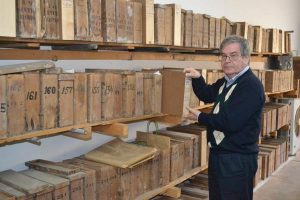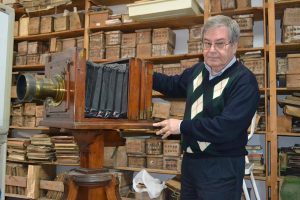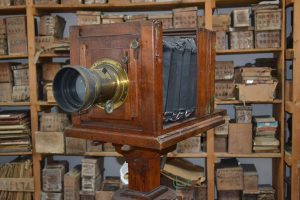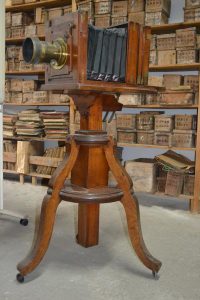Richard Ellis – the man, his times and his pictures
Marika Azzopardi
We’ve all seen them – pictures of Malta from days gone by, from centuries gone by. All signed by a man who photographed Malta like no other – Richard Ellis.
Meeting his great grandson Ian Ellis in the Ellis photographic archives which house somewhere between 36,000 and 40,000 images, allows me some insight on the man, his times and his pictures.
Richard Ellis was born in London in the year of the Lord 1842. One of 13 children, his parents thought fit to send him off to see the world at age 10 when he was apprenticed to James and Sarah Conroy. This couple worked in a circus and henceforth, Richard was officially part of a travelling troupe which toured Europe to thrill the crowds with the show. He eventually found himself in Paris.
It was in this city abuzz with novelty and fashion that Mr Conroy noticed how photography was becoming all the rage and decided to invest time and money to study this new and amazing image-making technique. The young Richard tagged along and as he did all the odd jobs around Conroy’s initiation in photography, the bright young boy learnt the tricks of the trade and mastered the art of photography, slowly but surely.
In 1861, the circus headed for Naples, intending to perform on the Italian peninsula, but whilst en route, Italy experienced its internal unification upheaval and the Conroys decided it was safer to head further south to Malta. Richard Ellis therefore, at age 19, ended up in Malta. Mr Ian Ellis explains further, “It was in Malta that Richard met a young woman called Fonza Curmi from Cospicua and they got married. In the meantime, Conroy had established himself as a professional photographer in Malta and it seems the man and Richard eventually parted ways since we know that Richard opened his first photography shop and studio in Strait Street, Valletta in 1871.”
Ellis had several advantages in Malta – for one thing he was British, had an English surname and this made him popular with the English settlers and visitors in Malta. He was also married to a Maltese girl, so his local connections were firmly entrenched as well. He was highly inventive and enterprising and whilst he was continuously commissioned by the British forces and its members to take pictures and portraits, he routinely came up with novel ways of making money. A picture shows two men rowing a ‘dghajsa’ sporting the ‘Ellis’ flag on the waters of the Grand Harbour. “This was one of his money-spinners apparently. He rented out the boat and took pictures of fleet ships as they entered the harbour. Then he would show the pictures to the sailors who came with them, offering to take each man’s photograph which he super-imposed on the ship’s image. It all turned into a souvenir postcard of Malta’s Grand Harbour, of the ship and of the sailor who proudly sent it back home to the family. Simple and ingenuous, it seems to have been pretty successful as an idea.”
Ian Ellis explains that whilst all this happened quite a long time ago, it has proved relatively straightforward to trace back events and to find things out as they happened in Richard Ellis’s life, from research, old documents and from his pictures. “He was very meticulous in documenting all his photos with the date, location, and the person/company commissioning the picture if this was the case. The first picture he took in Malta is of an English ship berthed at Senglea Point, a picture taken from Marsa.” Leafing through one of Richard Ellis’s large hand-written registers proves to be quite a treasure-throve of names of the gentry of his time, and Ian Ellis shows me related images which he managed to dig out of the archives and ‘develop’ from the old glass negatives and then transfer onto the computer. The variety is staggering – portraits of beautiful women, house interiors, hospital wards, equipment, roads, landscapes, people …
“I became involved in the care of this collection and in the eventual publication of his pictures quite perchance and quite late in life. I am by profession an engineer. I was pretty close to my uncle so that when he passed away aged 82, I was landed the responsibility of taking over his photography shop. Actually photography had been phased out of the business because by that time (1990s), photography was pretty much accessible to everybody and there was no scope in keeping the photography services going. My uncle had shifted to frame-making and in 1993, I decided to take over the business. I knew of the archive and over the past 10 years I have been sifting through it
His main difficulty was to scan the negatives to be able to view the actual pictures they produced. “I had visited a photography fair in Germany and asked about purchasing equipment to carry out the process. The price of it was exorbitant and the time it would have entailed me to see through the project would have taken me three lifetimes. So back home, I drew on my engineering prowess and came up with a solution whereby I have found an effective, fast and relatively cheap method to transfer the images from the old glass negatives onto the computer. This way I can see all the pictures, compare notes with the registers and add a caption to each and every one.”
It was this process which allowed him to publish the four books with images from the Richard Ellis collection, the first one showing images of Floriana and Valletta, a second one about the Grand Harbour and the Three Cities, a third about the St Julian’s/Sliema area, and a fourth one with generic views of Malta and Gozo. Presently he is working on the fifth and sixth publications. “My dream is to open a Museum of Photography of Malta because my great grandfather’s pictures truly document Malta as it was in his days and as it morphed over his lifetime. The pictures give us an opportunity to step back in time and see Maltese life as it was in all its aspects. There are his pictures, his equipment, his cameras … Yes, the books are one way of financing such a museum and I hope to find other funding for this scope. It is a dream which will hopefully materialise.”





